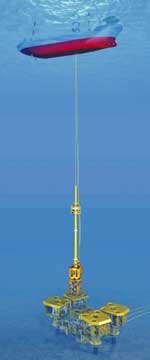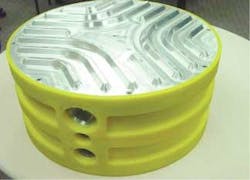Jaime Kammerzell • Houston
Light well intervention
The use of light well intervention in subsea wells on the Norwegian shelf may provide substantial safety gains and contribute to reduced operating costs, extended lifetime, and increased recovery totaling tens of billions of kroner, the Petroleum Safety Authority Norway (PSA) says.
Light well intervention allows a number of operations on subsea wells to be conducted without a riser to the surface. The technology is based on cable-based well maintenance, where the cable is routed via a subsea lock system into the well. Typically, electrical or smooth cable is used for logging, setting plugs, perforating, pulling equipment, and minor repairs.
Well interventions are challenging operations in terms of safety and require special expertise and control in all phases of the preparations and implementation.The use of light well intervention could provide substantial safety gains, among other things, because it avoids hydrocarbon transportation to the installation on the sea surface.
This year, the approximately 400 subsea wells on the Norwegian shelf will account for nearly half of the oil and gas produced. Statoil operates about 60% of the subsea wells, while Norsk Hydro's share is about 25%.
The recovery rate from platform wells is generally higher than for subsea wells. Even though there are differing opinions on how high the recovery rate will be through increased use of light well intervention in subsea wells, tests and experience from other countries' shelves and the industry's own forecasts show that the potential is substantial, the PSA said.
Subsea wells contribute to an increasing maintenance demand that has been carried out through well intervention from full-size mobile drilling units. Due to the limited availability of purpose-built light intervention ships, more expensive approaches have been used.
Light well intervention enables the use of smaller ship solutions instead of chartering large mobile installations to carry out simple operations on subsea wells. The technology also makes it possible to exploit the effect of consecutive well programs for longer periods of time, the PSA says.
Z Pod/Skid sea trials complete
Sonsub Inc. and Fairfield Industries have completed offshore sea trials of the Sonsub designed and manufactured Deployment Skid and Fairfield Industries' Deep Z Pod seismic acquisition technology.
The companies worked off of Sonsub's HOS Innovator in the Gulf of Mexico for eight days. They used Sonsub's Deep Z Pod Deployment Skid to lay out the pods. The Deep Z Pod Deployment Skid System, built by Fairfield Industries, is an ROV-mounted skid designed for deploying deepwater seismic data acquisition modules.
The Deep Z Pods are self-contained sensors that contain a precision clock, 4C recording, and an extended battery life. They record nearly noise-free, full Azimuth Long Offset full wave field seismic surveys in the deepwater environment.
Once deployed, the ROV transports the carousel system and the Deep Z Pods to the seafloor. The seismic data is acquired, and the Deep Z Pods are recovered back into the skid and then to the vessel, where the data can be recovered.
Excavation tool cleans up seabed
PSL Energy Services' says its excavation tool has carried out three seabed excavation contracts in areas as diverse as Libya, Newfoundland, and the North Sea.
AGIP has contracted the company to perform seabed clearance operations in Libya on the Sabratha development 100 km north of Tripoli. The work scope includes clearing mud and drill cuttings from the ocean floor. The cuttings were preventing the installation of a new subsea template. PSL used its Jet Prop 75 series excavation tool with Seabat real-time sonars and a Navibat seabed modeling system to ensure the seabed was leveled to within a tolerance of 10 cm.
Husky Energy commissioned the Jet Prop 25 series to excavate glory holes on the White Rose offshore oil development 350 km east of Newfoundland offshore Eastern Canada. Glory holes are excavated on the ocean floor and subsea structures are installed inside the craters to protect subsea installations from icebergs, which scrape along the seabed. The glory holes had become filled with mud and drill cuttings, preventing access to wellhead structures. Husky called in PSL to use their excavation tools to resolve the problem.
Finally, on Talisman's Tartan platform in the North Sea, subsea contractor Technip used the Jet Prop 25 and the Remote Jet Pumpsuction dredging tool to clear drilling mud and cuttings from around subsea structures, creating a stable area of seabed material for divers to work.
Subsea contracts awarded
FMC Technologies' Kongsberg Subsea AS unit will supply subsea systems and related services for the BP-operated Greater Plutonio project in block 18 offshore Angola.
FMC Technologies' scope of supply for the entire Greater Plutonio project will include 45 subsea trees and associated structures, manifolds, and production control systems, as well as connection systems for flowlines and umbilicals. The company also will supply technical services related to installation and start-up, as well as equipment through FMC Kongsberg Subsea's operations in Angola.
Deliveries will start in early 2005.
Marathon Petroleum Co. (Norway) has awarded a frame agreement to Aker Kværner covering the North Sea and Europe. Aker Kværner subsidiary, KOP, will supply subsea wellheads, side valve trees, over-trawlable protection structures, production control systems, and service support for subsea developments by Marathon in the region.
The first delivery will be to Marathon's Alvheim project. The initial order is valued at NKr250 million and consists of subsea production equipment for 11 wells. The Alvheim project is part of the PL203 development off Norway that includes Kameleon, Boa, Kneler, and East Kameleon.





